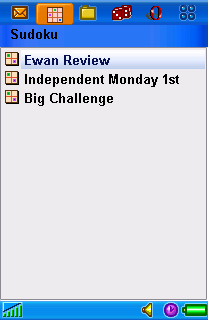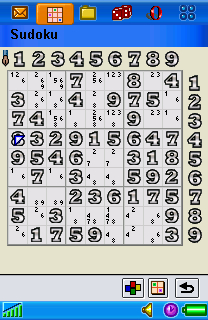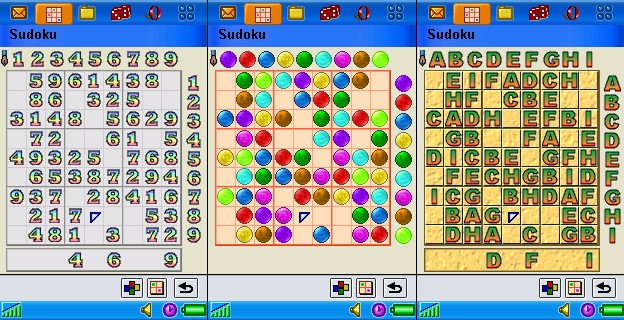Review: SuDoKu Professional
Score:
85%
Version Reviewed: 1.00F
Buy Link | Download / Information Link
 Ah, SuDoKu. How it has captured the minds of everyone in Britain and further afield. It’s a simple concept. Take a 9 by 9 grid, split that into 9 areas (each 3 by 3) and write in the numbers 1 through 9, ensuring that…
Ah, SuDoKu. How it has captured the minds of everyone in Britain and further afield. It’s a simple concept. Take a 9 by 9 grid, split that into 9 areas (each 3 by 3) and write in the numbers 1 through 9, ensuring that…
- No number is repeated in a horizontal line.
- No number is repeated in a vertical line.
- No number is repeated in each 3 by 3 area.
 All SuDoKu puzzles start with a pre-populated grid for you to work from. And with simple rules like that, no flash interface needed, it’s no surprise that there has been a bit of an explosion of SuDoKu applications across the Symbian platforms. And up till SuDoKu Professional (from ZingMagic), they all followed roughly the same pattern. A grid where you could add numbers, a certain number of built in puzzles, and the ability to enter a puzzle by hand (be it from a newspaper, online web site, or anywhere else).
All SuDoKu puzzles start with a pre-populated grid for you to work from. And with simple rules like that, no flash interface needed, it’s no surprise that there has been a bit of an explosion of SuDoKu applications across the Symbian platforms. And up till SuDoKu Professional (from ZingMagic), they all followed roughly the same pattern. A grid where you could add numbers, a certain number of built in puzzles, and the ability to enter a puzzle by hand (be it from a newspaper, online web site, or anywhere else).
So straight away, ZingMagic caught my attention because it could automatically generate its own random puzzles, freeing me from the worry of what I would do with the SuDoKu apps when I finished their built in puzzles. Purists will argue that they are not true SuDoKu grids as they might have more than one solution, but on a mobile device there have to be some compromises, especially when it’s only a very small minority that are going to make any fuss about this.
 ZingMagic have a strong line in classic games, and they all follow the same pattern in the user interface, so I was almost instantly at home in SuDoKu. The opening screen lists all the games that are currently playing. You could have the current puzzles from The Independent here, as well as an incredibly hard puzzle that the program generated for you last night. Tap the game, and you’re taken to the SuDoKu board.
ZingMagic have a strong line in classic games, and they all follow the same pattern in the user interface, so I was almost instantly at home in SuDoKu. The opening screen lists all the games that are currently playing. You could have the current puzzles from The Independent here, as well as an incredibly hard puzzle that the program generated for you last night. Tap the game, and you’re taken to the SuDoKu board.
You’ve got a number of easily switched graphic options, one for the colour scheme of the board and background, and one for the pieces you place on the board. You can use numbers, letters or coloured discs. Personally I’ve stuck to a very plain board and number set so there’s no distraction from the puzzle, but the numbers are still a bit ‘funky.’ Hopefully an update will add another number set that is a simple Arial Black font on a white background. Exciting, aren’t I?...
The other thing I really like is that you can add 'pencil marks' to your grid. These are smaller numbers and you can use them to try and work out what goes where – think clues to numbers and you’re there. Given that this is how I solve puzzles on paper, it’s a welcome addition.
One weird thing about the interface to me, is that it feels back to front. You have a cursor and you tap on either the top strip (for pencil marks) or the side strip (to place a number). I’m expecting that tapping a number will select it, and then I can tap on a square to place it again. Tap on another square and as it’s already selected it will be placed again. Nope, SuDoKu Professional is the other way around. When you tap a number it is instantly placed wherever the cursor is. So if you’re filling a few boxes of pencil marks of the number "8", rather than tap 8, tap box, box, box… you tap box, tap "8," tap box, tap "8," tap box, tap "8." It just feels wrong, and I hope a later build will allow you to choose the method of placing number between these two options.

But all told, SuDoKu Professional is a great time waster. It does what it needs to do and does it well. When I start ignoring an application to concentrate on what the result is (here it’s my SuDoKu skills being polished), that’s the mark of a good bit of code. Congratulations again to ZingMagic.
Reviewed by Heyden Smith at

